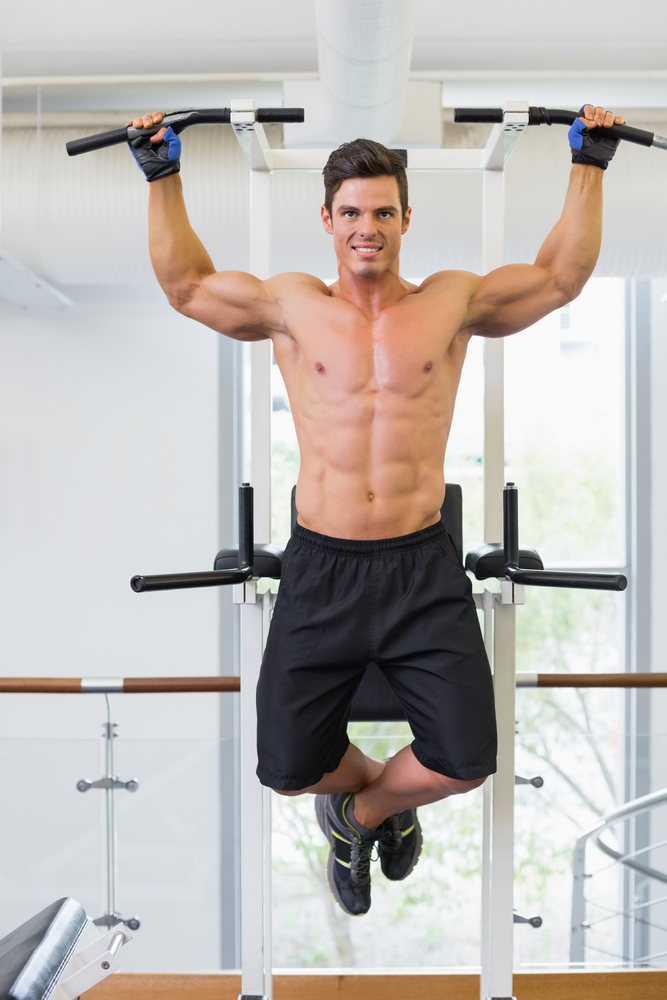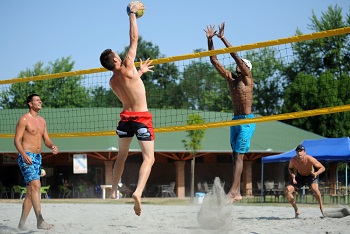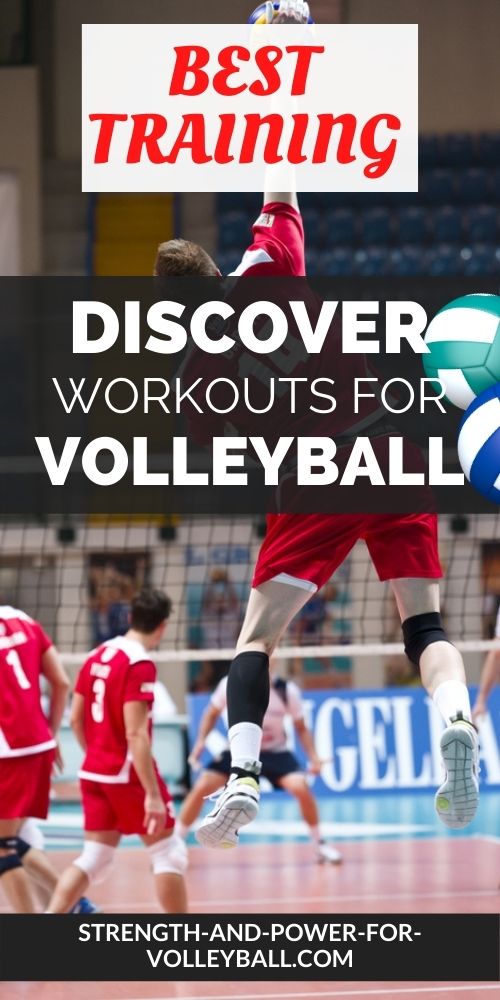Workout for Volleyball
Strength Training and Program Design
A workout for volleyball must contain strength training. Like almost all sports, strength is a vital component to being successful in volleyball.
Research has shown that resistance training can improve players' maximal force and power production, reduce the incidence of injury, and contribute to faster injury recovery times, thereby minimizing the number of missed practice sessions and competitions (1).
Basics of Strength Training for Volleyball
Develop Joint Flexibility
A workout for volleyball needs to include flexibility training. Most volleyball strength training exercises should use the entire range of motion of major joints, especially the hips, shoulders, knees, and ankles.
Exercises selected for the specific demands of a sport should maintain a balance of muscular strength across joints and between opposing muscle groups.
Exercising smaller muscles in isolation may also be necessary for the specific demands of a sport. For example, volleyball players may develop overuse injuries due to the repetitive nature of the overhead motion of hitting a volleyball.
To prevent these injuries, it may be necessary to include in a workout for volleyballshoulder strengthening exercises that focus on smaller muscle areas.

Develop Tendon Strength
Strength of muscles develop faster than tendon and ligament strength. Therefore, coaches should be careful not to overlook the importance of strengthening ligaments.
Tendons and ligaments grow strong through anatomical adaptation. Anatomical adaptation prepares the body for work by increasing tendon and ligament strength and correcting muscular imbalances.
Develop Core Strength
The abdominals and back muscles surround the core area of the body. Many times injuries could have been prevented just by strengthening the abs and low back.
However, theres more to core training than just strengthening these two areas.
In sports, the torso acts to support arm and leg actions. A strong core allows athletes to move more efficiently by keeping the core stable while assisting limbs in performing various athletic movements. For example, during the volleyball approach, an attacker that trained their core to stabilize, is better able to transfer power through their limbs (arms and legs) as they jump to hit.
Strength training the core isn't only about working core muscles in isolation (performing abdominal crunches or back extensions), but more importantly performing core stability exercises or training that takes a great deal of core stabilization.
Train Movements, Not Individual Muscles
By focusing on training movements, muscles are integrated and strengthened more efficiently, therefore increasing athletic performance.
A strength training workout for volleyball should simulate volleyball skill movements.
Volleyball players, like just about all athletes, should include multi-joint exercises in their training.
A triple extension is a good example of a volleyball specific multi-joint exercise. During a triple extension, you apply force with the feet against the ground extending your hips, knees, and ankles.
Cleans and snatches are good examples of power exercises that involve the triple extension movement common for volleyball players to use to improve their block and approach jump height.
If you enjoyed these tips and would like to keep it close to you at any time, just save this pin to your Pinterest Volleyball Training Board.
Things to Consider When Designing Workouts
Individualization
Each athlete must be trained according to individual ability, potential, and strength training background.
Many coaches make the mistake of designing a workout for volleyball following the programs of successful athletes, disregarding their own athletes needs, experience, and abilities.
Young athletes may not be ready biologically for such programs.
Variables such as biological and emotional maturity, training experience and level need to be considered when designing strength workouts for youth volleyball.
Specificity
To be effective, a program must be designed to develop sport-specific strength.
The role of strength training for sports is to create a stronger physiological foundation in order to improve one's overall ability to meet the needs of a sport and enhance his or her performance (2).
In considering a strength workout for volleyball, coaches need to think about the prime muscle groups and the dominant energy systems used for volleyball performance.
Strength training specifically to improve volleyball skills leads to a faster strength adaptation and improved sports performance.
Although specificity is an important principle, its long-term application can result in stressful, boring programs, leading to overtraining, overuse injury, and sometimes burnout.

Pull Ups
Progressive Overload
Overload refers to working out at a higher intensity than an athlete is used to.
If a training program is to continue producing higher levels of performance, the intensity of the training must become progressively greater.
Progression should be based on the athletes training status and used systematically in a workout for volleyball.
Testing strength helps in designing appropriate training intensity and progression.
Periodization
Improved performance is the direct result of the quality of training.
Variations in training specificity, intensity, and volume should be organized into training cycles.
A workout for volleyball must follow the concept of Strength Periodization, specific goals for each phase leading up to major competitions.
References
1) Mario A. Cardoso Marques MSc, Juan José González-Badillo PhD and
Darlene A. Kluka PhD. 2006: In-Season Resistance Training for
Professional Male Volleyball Players. Strength and Conditioning Journal:
Vol. 28, No. 6, pp. 1627.
2) Tudor O. Bompa PhD. 1996: Variations of Periodization of Strength. Strength and Conditioning: Vol. 18, No. 3, pp. 5861.
Workout for Volleyball Related Pages
Tips to improve jumping for the approach, spike, and block. The vertical jump is a combination of knee, hip, and ankle extension. Extending the hips involves working the glutes...
Volleyball workout program exercises. Do you need tips for designing a workout plan for volleyball? The following exercises focus on developing core strength essential for...
Top 5 Biggest Workout Mistakes
Top 5 workout mistakes by female volleyball players. Why are girls not getting the results they want when they are willing to work so hard? Most women...
How Full is your Glass? Increasing Relative Strength for Volleyball
Strength training programs for volleyball should include workouts
that involve focusing on relative maximal strength. Relative means being
strong relative to your specific body weight. Get stronger by
training...
Jump Training for Volleyball
Jump training tips for volleyball players. Plyometric exercises and
workouts specifically for volleyball. Learn the correct technique for
injury prevention and improving performance...
Evaluating Quickness Strength
Assessing quickness strength for volleyball. How quick are you? How
strong are you? How you should train for volleyball depends on how
strong and quick you are. Some players are slow and strong while
others...
Volleyball Jumping Exercises
Volleyball jumping exercises. Learn correct technique for jump
training. Plyometrics are the key to increase strength and explosive
power for volleyball. Depth jumps and jumps that involve getting
vertical...
Posterior Chain Training
Posterior chain training. Strengthen the muscles of the back, hips,
and hamstrings to increase explosive power for volleyball. Dysfunctional
glutes and weak hamstrings are often the limiting factor...
Volleyball Weight Training Myths, Part I
Should girls weight train? Does lifting heavy weight lead to a bulky body? Learn the effect of lifting weights on
burning fat and why strength training is superior to traditional cardio exercise
for weight loss.
Lower Repetitions at a High Intensity
Reps for volleyball weight training should be lower when training...
Testing Volleyball Strength and Power
Testing Strength is necessary for designing volleyball weight training programs. Volleyball players need...
Volleyball Strength Training
Weight training for volleyball should focus on ground-based,
multi-plane, multi-joint movements that match the biomechanical needs of
volleyball players...
Maintaining Healthy Shoulders for Volleyball
Weaknesses and imbalances of rotator cuff muscles can often lead to shoulder problems for the volleyball attacker. Strength...
Total Body Exercises for Improved Volleyball Performance
Weight training for volleyball should include total body exercises such as deadlifts and power exercises such as power cl...
Multi-joint Strength Training Exercises for Volleyball
Volleyball workouts consist of different types of strength training.
Resistance training exercises such as back squats, push ups, pull up
Core Strength Training for Volleyball
Volleyball weight training should include volleyball exercises for
strengthening the core. Core exercises such as ab curls, reverse hypers,
planks
Volleyball Flexibility Training
A volleyball players quality of movement is affected by flexibility. When a player has command of their flexibility...
Manipulating Program Design Variables
Volleyball program design and how to workout for volleyball. To be great at volleyball, the focus should be on improving strength and power. Volleyball strength training...
Volleyball Ankle Guards and Proprioception
Are volleyball ankle guards worth it? What's the best way to protect your ankles while playing volleyball? Exercises for injury prevention and braces...
Key training exercises for youth volleyball players. Techniques for Learning correct movement patterns for becoming an elite volleyball athlete.
3 Workouts at Home
Volleyball workouts at home. Increase your power and agility with this comprehensive plan tailored to meet your fitness goals.
Strength Training For Spiking and Jumping
Strength training for volleyball will improve performance and reduce your risk of injury. Strength training is a must for any volleyball player who wants to compete at the highest level.
Leg Training
Leg workouts for volleyball players. Learn how to workout and use these volleyball workouts to jump higher and improve quickness. Off-season and in-season training.
Core Workouts
Volleyball core workout for volleyball players. How to workout at home for volleyball. Build strength and do the correct exercises for volleyball players.
Volleyball › Workout for Volleyball
- Home
- Strength Training

